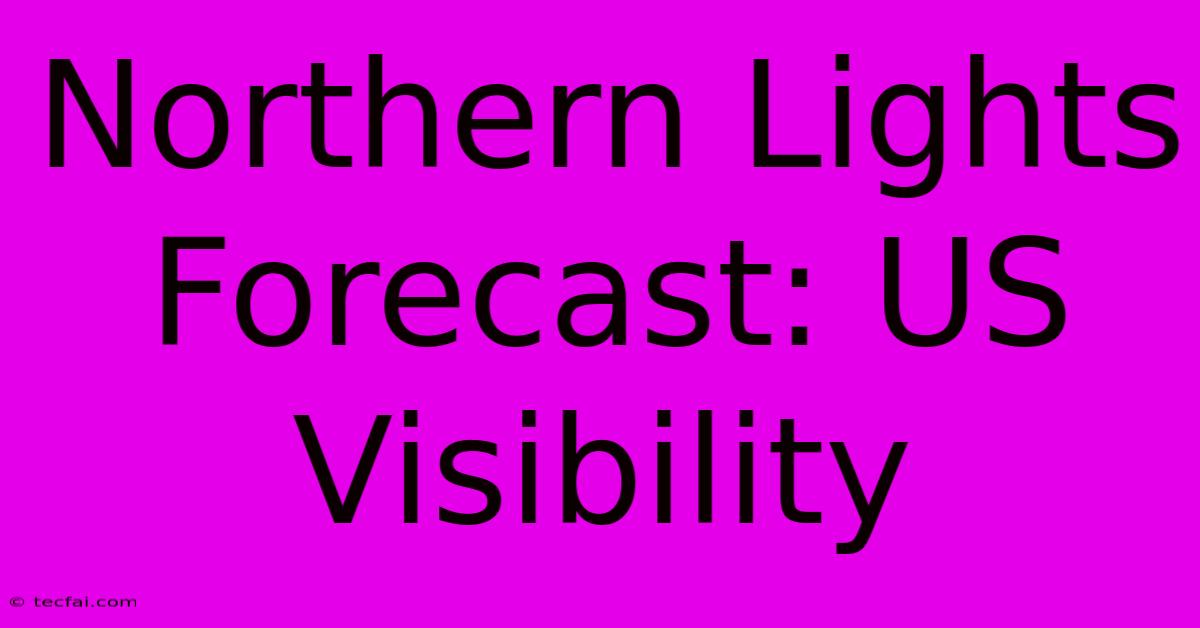Northern Lights Forecast: US Visibility

Discover more detailed and exciting information on our website. Click the link below to start your adventure: Visit Best Website tecfai.com. Don't miss out!
Table of Contents
Northern Lights Forecast: US Visibility
Witnessing the Aurora Borealis, the magical Northern Lights, is a bucket-list item for many. But for those of us in the US, the question always looms: when and where can we see them? This guide provides an up-to-date look at the Northern Lights forecast and the best places in the US for optimal viewing.
Understanding the Aurora Forecast
Predicting the Aurora is a complex dance of solar activity and atmospheric conditions. The key element is the Kp index, a geomagnetic storm scale ranging from 0 (quiet) to 9 (extreme). Higher Kp numbers mean a greater chance of seeing the aurora at lower latitudes. While websites and apps provide real-time Kp predictions, remember that these are forecasts, not guarantees. Other factors influence visibility, including:
- Solar Wind Speed: A faster solar wind increases the likelihood of auroral activity.
- Cloud Cover: Even with a high Kp index, clouds will completely obscure the lights. Check weather forecasts meticulously!
- Light Pollution: City lights drown out the faint aurora. Escape to dark sky areas for the best viewing.
Where to Find Reliable Forecasts
Several sources provide reliable aurora forecasts:
- Space Weather Prediction Center (SWPC): This NOAA-run center offers official geomagnetic forecasts and alerts.
- Aurora forecast apps: Many apps provide personalized forecasts based on your location. These apps often integrate data from SWPC and other sources.
- Dedicated aurora websites: Numerous websites specialize in aurora forecasts, often incorporating visual representations and community reports.
Best US Locations for Northern Lights Viewing
While Alaska is the most reliable US location for viewing the Northern Lights, auroral displays can sometimes be seen much further south, depending on solar activity. These areas offer a blend of accessibility and dark skies:
Alaska: The Aurora Hotspot
Alaska is your best bet, with numerous locations offering excellent viewing opportunities. Consider:
- Fairbanks: A popular choice, offering organized tours and dark skies away from city lights.
- Denali National Park: Stunning scenery combines with minimal light pollution for breathtaking aurora displays.
- Arctic Circle: Venture further north for the greatest chance of seeing the aurora, though access can be more challenging.
Other Northern States: A Long Shot, But Possible
During periods of high solar activity (Kp 6 or higher), there's a small chance of witnessing the aurora in states like:
- Northern Minnesota: The northern reaches of Minnesota offer dark skies, increasing the odds during strong geomagnetic storms.
- North Dakota: Similar to Minnesota, northern North Dakota provides a relatively dark viewing area.
- Montana & Idaho: While less likely than Minnesota or North Dakota, very high Kp indices might offer a glimpse in these northern states.
Important Note: Even with a high Kp index, sightings in these lower latitude states are far from guaranteed. Be realistic about your expectations.
Maximizing Your Chances of Seeing the Aurora
- Check the forecast frequently: Aurora activity can change rapidly.
- Go during the winter: Longer nights offer more viewing time.
- Find a dark location: Get away from city lights.
- Be patient: Auroras can be elusive. Give yourself ample time for viewing.
- Dress warmly: Northern winters are cold!
- Bring a camera: Capture the magic!
Conclusion: Patience and Preparedness Pay Off
Seeing the Northern Lights in the US requires patience, preparation, and a touch of luck. By monitoring the aurora forecast, choosing a suitable location, and understanding the factors influencing visibility, you significantly increase your chances of witnessing this breathtaking natural phenomenon. Remember to check multiple forecasts and be prepared for potential disappointment, as the aurora is a capricious celestial dancer. But when you do see it, the experience will be unforgettable.

Thank you for visiting our website wich cover about Northern Lights Forecast: US Visibility. We hope the information provided has been useful to you. Feel free to contact us if you have any questions or need further assistance. See you next time and dont miss to bookmark.
Featured Posts
-
Real Madrid Vs Liverpool 2 0 Score
Nov 28, 2024
-
Live Score New Zealand Vs England Test
Nov 28, 2024
-
Youth League Juventus Defeats Villa
Nov 28, 2024
-
Difficult Driving Ni Weather Warning Issued
Nov 28, 2024
-
Powerball Winning Number Trends Data Analysis
Nov 28, 2024
